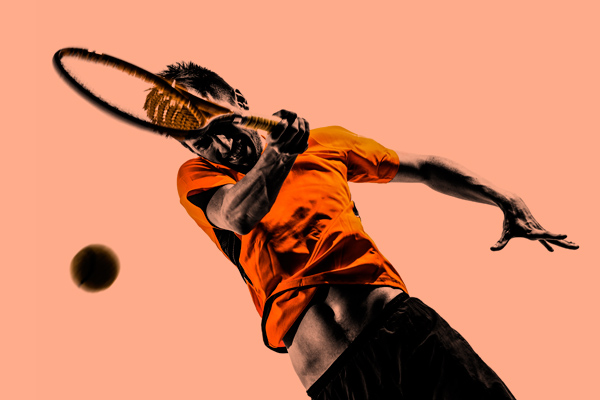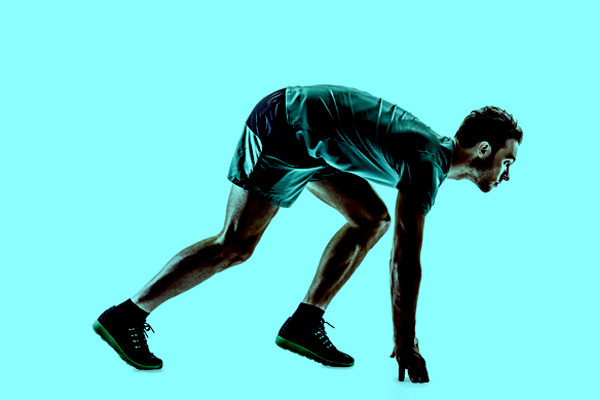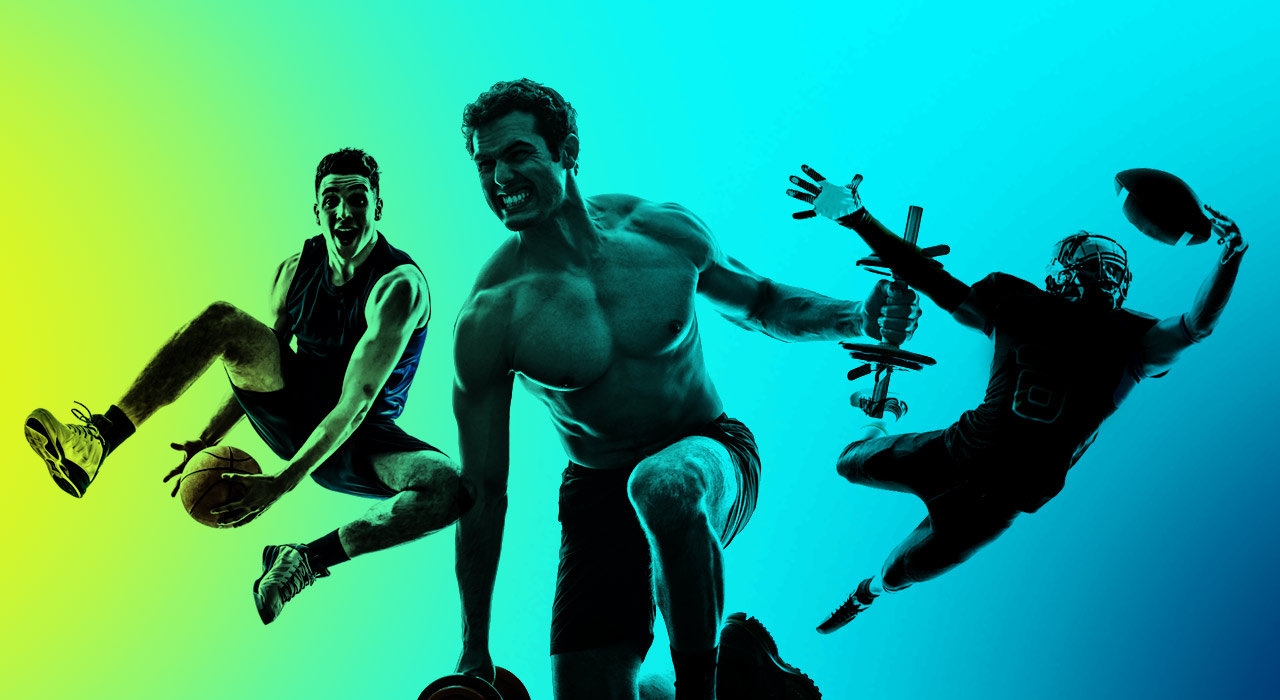Get fit; be better at sports, right? If you’re looking at it that simplistically, you’re set up to fall flat on your face. Here’s how you can improve your sports performance training for your specific sport.
Your trainer:
Brandan Fokken
IFBB physique pro, Bodybuilding.com and Dymatize athlete.
Optimal sports performance training for your specific sport:
Weightlifting
Everyone’s body is very different, so some people will do as much cardio as the football player and others may not even do 30 minutes a week. Most weightlifters that do cardio keep their sessions short – nothing more than a couple of 8-10 minute HIITs and a 10-15 min LISS session or two.
Cardio eats muscle when done to excess and, if you’re bound to strength and muscle, shorter cardio sessions make sense. Though the treadmill is the most used, it is amateur hour. The stairmaster is good and the bike is great, it’s easy on the joints and has proven to aid in recovery more than others.
Still, you can do better by doing HIITs with full body movements and exercises that will help with your main lifts. Here are the best: kettlebell swings, battle ropes, weighted ball slams, tire flips, TRX push-ups and rows.
Now all you have to do is go all out for 30 seconds as many reps possible, follow that with one minute of active rest, and then repeat for 6-10 intervals.

Running
What do most runners do for cardio? They run in a straight line for long periods, but they should avoid the treadmill at all costs. While it may seem like sports specific training for runners, it’s not the same as running on the ground as you’re just lifting your feet. Plus, you’re better off training in race-like conditions. Whether it’s running trails, the beach, or the road, that is what you want the bulk of your training to simulate.
The smaller portion of your training (let’s say 30%) should consist of a variety of HIIT and aerobic endurance. A few good exercises for HIIT include running hills, swimming and cycling.
And for the aerobic endurance you could try aqua jogging, swimming and cycling again. Because running is high impact and is a large part of a runner’s training, you need to give your joints a break without sacrificing days of cardio. You do that by adding those low impact aerobic exercises.
And with the HIITs, you can always change the intervals. Instead of doing high intensity for 30 seconds, try a minute followed by a minute or two of active rest.
Soccer
For soccer, optimal sports performance training is a balance between endurance training, interval training, and speed/power/agility drills. A good start would be to limit the longer endurance runs to 2-3 times per week.
With the remaining days, split them equally between HIIT sprints and the speed/ power/agility drills. For the HIIT days, one day would focus on the short sprints – 10, 20, 30, all the way to 60-yard sprints. The other HIIT day would target the moderate distance runs, similar to the overall pace of play, close to jogging or a bit faster.
Go by interval length of time instead of by distance for these. For example, you would do a five-minute run (heart rate elevated to around 75-85% of max HR) followed by a four-minute active rest period, and then repeat that 2-4 more times.
The two days for footwork drills are much the same. You want to mix and match a variety of speed/ power movements with footwork/coordination exercises (with a ball and without a ball) that cover every angle.
A few drills that are great for agility and coordination include: ladder drills, five-dot footwork drills, and cone courses. Sled training, parachute running and resistance bands are also worth including. Exercises for speed and power include: hang cleans, jump squats (weighted), push presses, weighted or unweighted lunge jumps, row machine, broad jumps, and kettlebell swings.

Cycling
The difference between runners and cyclist is that the latter don’t need to shun the stationary bike because it is low impact, however like runners, cyclists should train in race conditions if they want to perform their best. Running does have a part to play, especially running ladders. It’s a good combo of agility, cardiovascular, and strength training.
You may be wondering why cyclists need to be agile. Well, they don’t, but it does help with coordination and balance, which is vital when speeding down the road with a pack of fellow cyclists. It also makes for a good HIIT session that will help during the sprinting parts of the race.
Two other excellent exercises to incorporate are stair sprints and the row machine. While sprinting stairs is great for targeting the lower body, the row machine will also target the back and core. Because cyclists ride with their back at an angle or bent over, their backs must be strong as well as their core. This makes the row machine ideal for HIIT workouts and even some longer distance training.
Court sports (basket ball, tennis, squash)
Court based sports, such as basketball, are ranked among the top for difficulty. These demand strength, endurance, balance, agility, and tremendous hand-eye coordination, so training is best done in stages.
Stage 1: Endurance
Do 3-4 moderate intensity sessions for 30-40 mins.
Most athletes will hop on a bike or treadmill to get these out of the way. Don’t be like most people. You will get the most benefits by doing full body exercises. Instead of a boring treadmill or bike, try swimming for 30 minutes. With that, it never hurts to switch things up, so with each lap you do, change the stroke.
The rowing machine’s full body workout is great for endurance sessions and interval training, too.
Stage 2: Sprints
Here you will focus on those high intensity bursts and acclimating your body to that very nature of the game. Keep one endurance session per week and add in 2-3 interval sessions. The work/rest ratios you want to use are 1:1, 1:2, and 1:3. It’s OK to start out with longer interval times (i.e. 2 minutes active/2 minutes rest, 1 minute active/3 minutes rest) and feel free to mix up the ratios throughout a session.
However, the second half of this stage you will want to simulate more game-like conditions. This means your intervals should drop in length, with most of the high intensity intervals being under a minute. While the rowing machine is great, court agility drills are better, so sprint to a point on the court, shuffle to the next, then back pedal and sprint to finish, do ladder footwork drills, plyometrics (box jumps, lunge jumps, one-legged hops/jumps), and dot drills/quick feet.
Stage 3: Sports drills
At this point you can drop the endurance session and move to 1-2 interval training days and 2-3 days of skills training. The latter will be very similar to the interval style as far as the work/rest ratio. Essentially what you’re doing here is incorporating a game skill into a HIIT workout to increase your performance when you’re fighting fatigue toward the end of the game.
A great basketball drill for this stage is the sprint/free throw drill. Start by sprinting half the length of the court 15 times (down and back is two) within a certain timeframe (we’ll say 15 times in under 60 seconds). Immediately after the sprints shoot two free throws, two jump shots, and two three- pointers (keep track of your number of misses).
Actively rest for 1.5-2 minutes, then sprint half the court again 12 more times in under 50 seconds. Grab a ball right away and take two of each shot like before. This time rest only one minute before sprinting half the court nine more times trying to finish under 40 seconds.
Again, take two of each shot right after sprinting and calculate your percentages for each shot. You can deduct one sprint from the final set if your free throw percentage is greater than 75%. Deduct another one if your jump shot is greater than 60%. Lastly, deduct another if your three-pointers are greater than 35%.
The last round of sprints can be anywhere from eight to 15 sprints. You can vary the amount of rounds and number of shots, but keep the rest times relative to the number of sprints and decrease them with each round to simulate faster gameplay like that before half time or the
end of the game.
The gain from sports specific training
In closing, you should always look at how your training regime will enhance your sports performance if you’re at all serious about your sport. The two things go hand in hand so you’d do well to marry your fitness with a sports specific training routine to kill both birds with the proverbial (atlas) stone. Take your sports performance training seriously and it will repay with you some serious strides in your sport.
For more articles like improving your sports performance training, interviews and more, get TRAIN magazine direct into your inbox every month for free by signing up to our newsletter







